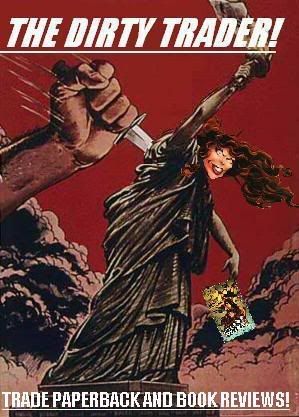
"When I was a child, I used to speak like a child, think like a child, reason like a child; when I became a man, I did away with childish things."
Given that I'm writing a review for a "graphic novel," none of that really applies to me. However, when I was a child, I tried reading comics like Swamp Thing and The One, and was in way over my head. Not only didn't I really understand the books at the time, but their edgy sophistication unnerved me. Getting into my teens, my mind expanded, but I still needed transitional mediums between the super-hero world and an adult one. These included the anti-heroic likes of Batman (The Dark Knight Returns, The Cult,) the Punisher, Grimjack, and Marshal Law. These led me to characters still further estranged from the funny book mainstream, like Morpheus, until I finally became comfortable with mature reading completely divorced from the genre fantastic. By that point, I could look back on books like Watchmen and Brat Pack not only unafraid, but unimpressed.
My first encounter with Mister X was a random issue in a quarter box. In the early '80s, there was a sea change as new independent creators entered the field with no delusions about the nature of work for hire comics and a desire to expand the medium from the edges of the frontier. However, my exposure to this avant-garde was mostly limited to ads in books like Heavy Metal back when I couldn't rely on living anywhere long enough to chance paying for something that would come to a mailing address. Besides, I wasn't digging through the discounted castoffs because I was flush enough to pay inflated low print run cover prices or shipping charges. I tossed through the issue, with interiors that surely didn't match the sleek new wave covers, lacking color, involving people in normal clothes having discussions, with no supporting issues to reference or progress toward. I simply was not prepared to take that plunge.
In the decades that followed, occasional Mister X material was released, and though I felt pangs of interest and guilt, I always passed. The book was revered, but I had no clear point of entry, at least not at a reasonable price. Finally, a few years ago, Dark Horse announced that Dean Motter would be rebooting and reintroducing his creation in an accessible mini-series. I ordered the trade, which collected a thin four issues and was produced in dimensions from that netherworld between standard comics and digests. For some reason, I have a tendency to shove those types of books on a shelf and forget about them for years, as I did with Mister X: Condemned. Only recently did I stuff it into my work bag for lunchtime reading.
Radiant City is an art deco, rigorously calculated creation of a team of architects, intending to work directly on the psyche of its inhabitants. The concept was successful, but not the ultimate result. Rather than being healthy, happy and productive, the city's citizens were driven to bleak neurosis by the design of the metropolis mockingly nicknamed "Somnopolis." A penitent but unbalanced architect dubbed "Mister X" attempts to correct his mistakes by helping to deal with the impact of his creation, including a rogues gallery of creeps straight out of German expressionist filmmaking. Mister X haunted the city like the title haunted the '80s, producing a couple dozen or so issues and influencing filmmakers like Terry Gilliam, Tim Burton and Alex Proyas. It is a compelling premise both perfect for and distinct from standard comics.
Unfortunately, it's also problematic in execution. While conceived by Motter, the early issues were created by Los Bros Hernandez, who quit over payment issues. Motter began doing the actual writing with the fifth issue, but had Seth as a hired hand on art. Other writers and artists produced later issues, making Mister X an early model for the Image Comics studios system of basically pulling the same freelancing contract crap they'd left Marvel over when it was theirs to sign. Condemned appears to be one of the few times Motter has written and drawn his owned damned creation, and the result is tepid. The retro-futurism of modern life filtered through a 1930s aesthetic is now passe. The plot and characters are also very much of that era, meaning an overcooked but under-seasoned plot involving bland, flat subjects. There's a murder mystery and rampant conspiracies, but they're all of the type seen elsewhere, across decades, handled better. What may have been innovative thirty years ago is now rote, and frankly, I suspect the book's reputation had more to do with "helpers" like Paul Rivoche than its credited author, anyway.
I still very much want to read the Mister X guys like Howard Chaykin and Warren Ellis rave over, but this effort only served to diminish my curiosity rather than inflame it. It's a book that tells you it has an interesting premise in the first panels, then neglects to show anything nearly as intriguing as what was suggested. The sluggish narrative manned with interchangeable characters is then sloppily wrapped up in the last few pages, once again through people holding guns while telling you their motivations and prior actions rather than demonstrating them with subtlety. The floorboards are loose, the pipes are rusted, and the whole construct looks ready to fall in on its foundation. This project was at least honest in its title, as it should rightly be condemned.



No comments:
Post a Comment